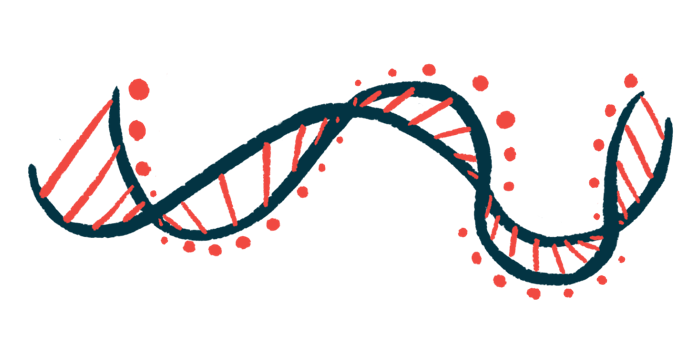Gene Activity Profiles in Rett May Determine IGF-1 Therapy Response
Rett children whose apnea eased with treatment had distinct profiles

Children with Rett syndrome whose disturbed breathing eased after treatment with mecasermin, a lab-made version of the growth hormone IGF-1, had unique gene activity profiles before and in response to treatment, according to an analysis of Phase 1 trial data.
These findings suggest that different molecular subgroups were evident at the trial’s beginning and support the use of gene activity profiles as biomarkers for response to IGF-1 and related therapies, the researchers noted.
The analysis, “Molecular Signatures of Response to Mecasermin in Children With Rett Syndrome,” was published in the journal Frontiers in Neuroscience.
Rett is mainly caused by mutations in the MECP2 gene, which controls the activity of other genes essential for normal brain development. These mutations lead to cognitive, emotional, and sensory disturbances, as well as problems with the heart, digestion, and breathing.
IGF-1 is an essential growth factor protein needed for proper brain development. In the brain, IGF-1 is broken down into glypromate (GPE), a protein fragment thought to improve the structure of connections between nerve cells and to lower inflammation.
Profile changes seen in apnea responders, non-responders
Trofinetide (NNZ-2566), an investigational oral therapy for Rett, is a modified form of GPE currently being evaluated in the Phase 2/3 DAFFODIL trial (NCT04988867) in girls ages 2 to 5. Top-line data from the recently completed Phase 3 LAVENDER trial (NCT04181723) showed that trofinetide lessened neurobehavioral symptoms and aided communication and in Rett girls and young women.
Mecasermin, marketed as Increlex, is a lab-made version of IGF-1 approved for long-term treatment of growth failure in children with severe IGF-1 deficiency. The therapy is administered by subcutaneous (under-the-skin) injection.
As an investigational therapy for Rett, a small and open-label Phase 1 study (NCT01253317) by Boston Children’s Hospital in Massachusetts showed that mecasermin eased anxiety, improved mood, and restored abnormal brain wave readings, a marker for behavioral disturbances. Mecasermin treatment also markedly improved apnea, or the slowing or stoppage of breathing, a sign of breathing impairment in Rett.
A larger Phase 2 trial (NCT01777542) demonstrated that mecasermin significantly improved social communication and behavior in treated patients compared to those on a placebo, but it did not replicate the apnea results from the first trial.
These findings prompted researchers at the St James Hospital in Ireland, Boston Children’s and other institutions to examine molecular profiles associated with therapeutic responses to mecasermin using data from the Phase 1 trial. This work may also identify biomarkers to help predict responses to mecasermin or other IGF-1-related therapies.
The Phase 1 study, which included nine classic Rett patients, consisted of a four-week multiple ascending dose (MAD) period to measure safety and pharmacological properties, followed by a 20-week and open-label extension (OLE) period to assess mecasermin’s potential efficacy.
Whole blood samples were collected before and after the MAD and OLE periods, then analyzed for gene expression (activity). Across all participants, no overall differences in gene expression were seen throughout the trial, from pre-treatment (baseline, or study start) to the end of the OLE, and no relationship with disease severity based on mutation.
At baseline, four patients had moderate-to-severe apnea, defined as stopping to breathe for more than five times per hour. By the end of the OLE, all four showed improvements, reflected in a lower apnea index.
Notably, gene expression profiles between apnea responders and the other five patients, a reference group, diverged before treatment, “which is consistent with their clinical profiles and outcome,” the researchers wrote.
Further investigation found that genes with different expression profiles were involved in IGF-1 signaling, cell cycle regulation, immune responses, and breathing regulation.
At baseline, a strong correlation existed between gene expression profiles and apnea index across all nine participants. This relationship was mainly driven by those who had moderate-to-severe apnea.
During the initial four-week MAD phase of the trial, gene expression was relatively higher in the responder group, which then reversed during the 20-week OLE phase. Here, the responder group showed limited gene expression changes with mecasermin treatment, while the reference group had marked differences in gene activity.
The findings confirmed the “existence of different ‘molecular’ subcohorts at the beginning of the trial,” the scientists wrote. “The two groups, identified by their genomic profiles, appeared to respond differently to mecasermin treatment, with the [reference or non-responder] group showing more changes.”
Genes whose expression changed the most in reference patients during the OLE were associated with immune activation and inflammatory processes.
Reasons for these results are not known, the researchers noted, but deserve “further examination since these molecular changes may disclose key events associated with response to IGF-1 and related compounds.”
“Our analyses revealed gene expression profiles associated with severe breathing phenotype and its improvement after mecasermin administration in [Rett], and suggest that inflammatory/immune pathways and IGF-1 signalling contribute to treatment response,” the scientists wrote.
“Overall, these data support the notion that [gene expression] profiles have potential as biomarkers of response to IGF-1 and related compounds.”







